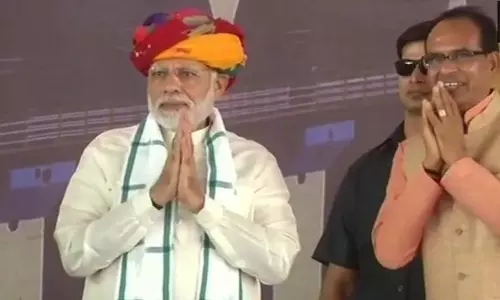
The mothers of Ayushman Bharat
text_fieldsA report recently published in The Lancet, one of the most authentic medical journals in the world, specifically lays bare India’s health emergency.
The report says that 24 lakh people die every year due to the lack of adequate treatment; of this, the lives of 16 lakh people were claimed by the poor healthcare facilities. In the study conducted in 136 countries, The Lancet shows that the present state of the health sector in India is very pathetic. Considering a report by the National Crime Records Bureau which says that in the last 15 years, about 3.8 lakh people had resorted to suicide, the reasons for the health crisis faced by the nation can be understood. Although diseases such as polio, tetanus and measles have been more or less contained through national vaccination programs and other schemes in the past 3.5 decades, contagious diseases such as malaria and dengue pose a threat even today. Diseases like heart diseases, cancer and diabetes claim more lives now than earlier. Not announcing and implementing a comprehensive health policy is the only fundamental reason for this crisis.
Let us recall that ‘Right to life’ is one of the constantly repeated slogans post World War II. Seven decades later, that slogan has become the ‘right to healthy life’. The crux of the slogan is that it is not just about merely living but to live in perfect health and that the government should provide the required facilities in order to accomplish that. It is when organisations including the World Health Organisation (WHO) have taken up this slogan and several countries are even mulling over a constitutional amendment of that kind that the heath scenario in India has been becoming worse. What is more painful is that most of the victims of this health emergency in the country are women and children. This pushes into uncertainty the future of a nation which is in the forefront of human resources. Although maternal and infant mortality rates have been checked to an extent, things cannot be considered stable when we are compared to other countries that have achieved economic growth as ours. A study conducted by ‘Naandi Foundation’ which functions in Mumbai, on the health issues faced by the teenagers in the country proves this. The study says that more than half of the teens and those who are underweight suffer from anaemia. About 46 per cent girls do not have facilities even for hygiene protection during menstruation. Many of them do not have access to required healthcare services. About 69 per cent of them lack the basic healthcare facilities in their own place; the study also says that at least 26 per cent people have been denied treatment for want of money. In short, treatment facility and the financial status to avail it, can be considered as the crux of the problem. Will Ayushman Bharat which has been described as Modi government’s crucial weapon/trump card, be able to resolve this crisis? It can be said that there is little hope in the present situation. Criticisms have been raised against this scheme which claims to provide health insurance of Rs 5 lakh every year to the 10 crore citizens of the country. Only Rs 2,000 crore have been allotted to the scheme which needs at least Rs 3,000 crore. One could easily guess how inadequate this is.
In most of the discourses on study of health sector, Kerala can be seen standing out like another 'Republic'. By any standards of health services, Kerala is one step ahead. In longevity and maternity/infant mortality, Kerala is way better above the national average, as vouched for by studies cited above. In that sense, although Malayalis have cause for delight and pride, some moderate concerns do exist in Kerala as well. Deaths caused by malnutrition are happening here too, although it does not receive sufficient attention as it happens mostly in alienated sections. Over the last five years, around a hundred children died in Attappadi because of undernutrition. A Unicef survey team that visited Attappadi had discovered that even iron and folic acid tablets that are administered to pregnant women, were not available in the primary health centres there. The Central Government granted an amount of Rs 220 crore to eradicate infant deaths, and the state government also added a substantial allocation to it. But, in Attappadi and tribal areas including Wayanad, infant deaths still continue. And the recurrence of several diseases generally in Kerala, which were once thought to have been eradicated, has weakened the health sector. Eight children died of diphtheria in the last three years, not because treatment was not available, but because treatment was declined deliberately due to several pesuasions. In addition, some nascent and unhealthy habits of going for unscientific treatment streams are also sowing seeds of a health emergency in Kerala. If these trends are not reined in, Kerala’s health model will remain just a legend.











